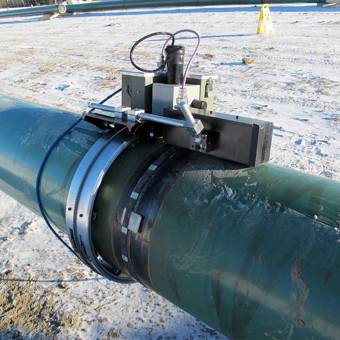Comprehensive Introduction of Pipe Welding Inspection Procedures
Pipe welding inspection treatments play a vital function in guaranteeing that welded links fulfill rigid sector requirements and specifications. From meticulous pre-welding examinations to thorough post-weld evaluations, a distinct evaluation process is necessary for keeping the structural soundness of pipes.
Pre-welding Inspection Preparations
Before beginning the welding process, complete pre-welding inspection preparations are important to guarantee the stability and top quality of the weld joint. These preparations entail a thorough assessment of the materials to be bonded, the welding tools, and the work environment. By conducting complete pre-welding examination preparations, possible issues can be recognized and resolved early on, leading to top quality and trusted weld joints.
Welding Procedure Certification
Thorough pre-welding evaluation preparations lay the foundation for the crucial procedure of Welding Treatment Certification, ensuring the stability and quality of the weld joint. Welding Procedure Qualification (WPQ) is an important action in the welding process that includes screening and accrediting welding procedures to ensure they meet details requirements and needs. The WPQ process commonly consists of welding procedure specification development, welding treatment credentials testing, and paperwork of the outcomes.
Throughout welding procedure spec development, important details such as the welding process, welding products, joint design, and welding parameters are specified to develop an extensive procedure. Consequently, welding procedure qualification testing is conducted to validate the suggested treatment's honesty. This testing commonly entails welding examination coupons that undergo various mechanical and non-destructive examinations to analyze the weld's top quality and adherence to the defined criteria.
In-process Weld Evaluation
During the welding process, in-process weld inspection plays an essential duty in making sure the high quality and stability of the weld joint - Pipeline Welding Inspection. This kind of evaluation involves keeping track of the welding parameters, examining the weld grain formation, and detecting any prospective flaws or interruptions as they occur. By performing in-process weld inspections, welding operators can quickly address any kind of concerns that might arise, thus making certain and avoiding additional issues that the final weld satisfies the called for specs
Typical approaches used for in-process weld evaluation consist of aesthetic inspection, liquid penetrant screening, magnetic bit screening, ultrasonic testing, and radiographic testing. Visual evaluation is often the very first step at the same time, allowing inspectors to visually evaluate the weld for surface area abnormalities such as fractures, porosity, or incomplete fusion. Advanced methods like ultrasonic screening and radiographic testing supply thorough insights into the internal structure of the weld, making sure that there are no concealed problems that could compromise the weld joint's stamina and stability. Overall, in-process weld inspection is necessary for maintaining the top quality and dependability of bonded pipes.
Non-destructive Testing (NDT)
Non-destructive Screening (NDT) is a crucial technique employed in pipeline welding inspection to analyze the integrity of weld joints without triggering damages to the welded framework. By using different NDT strategies, inspectors can review the quality of welds and recognize any flaws or discontinuities that may jeopardize the architectural sturdiness of the pipeline. Usual NDT techniques utilized in pipe welding inspection include Radiographic Screening (RT), Ultrasonic Screening (UT), Magnetic Fragment Examining (MPT), Liquid Penetrant Screening (LPT), and Visual Testing (VT)
RT entails the use of X-rays or gamma rays to produce pictures of the interior framework of the weld, permitting inspectors to identify issues such as porosity, fractures, or incomplete fusion. Furthermore, VT includes aesthetic inspection of welds to recognize any kind of visible blemishes.
Post-weld Inspection and Documents


Documents of post-weld assessment findings is important for keeping quality assurance documents and ensuring conformity with industry criteria and guidelines. Detailed reports should include info regarding the assessment approaches used, the area and nature of any type of issues found, and any kind of restorative actions taken - Pipeline Welding Inspection. Correct documents not just acts as a document of the weld's quality yet also aids in future upkeep and assessment processes
Conclusion

In verdict, pipe welding evaluation treatments play an important duty in making sure the top quality and integrity of welds. In general, adherence to proper inspection protocols is essential to the success of pipeline welding tasks.
From meticulous pre-welding assessments to detailed post-weld assessments, a distinct evaluation procedure is crucial for maintaining the architectural soundness of pipes. By performing in-process weld examinations, you could try these out welding drivers can quickly attend to any concerns that might develop, thereby avoiding further issues and ensuring that the last weld meets the needed requirements.
Typical techniques used for in-process weld evaluation consist of visual assessment, fluid penetrant testing, magnetic particle screening, ultrasonic testing, and radiographic screening.Non-destructive Screening (NDT) is a critical technique utilized in pipe welding assessment to analyze the stability of weld joints without triggering damages to the welded structure. Post-weld inspection entails various techniques to analyze the welds for flaws, consisting of aesthetic inspection, dye penetrant screening, magnetic fragment testing, ultrasonic screening, and radiographic testing.